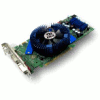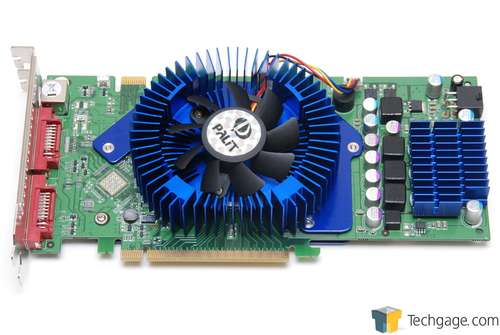- Qualcomm Launches Snapdragon 4 Gen 2 Mobile Platform
- AMD Launches Ryzen PRO 7000 Series Mobile & Desktop Platform
- Intel Launches Sleek Single-Slot Arc Pro A60 Workstation Graphics Card
- NVIDIA Announces Latest Ada Lovelace Additions: GeForce RTX 4060 Ti & RTX 4060
- Maxon Redshift With AMD Radeon GPU Rendering Support Now Available
Palit GeForce 8800GT Super+1GB

We’ve been fans of NVIDIA’s 8800 GT since launch, and Palit helps us remember why. Though utilizing reference clocks, the Super+1GB doubles the competitions memory, but as we found out, it’s difficult to see a difference. Overclocking yields far better results, and luckily, this card delivers there as well.
Page 1 – Introduction
Without question, the “hot” GPU of the moment is NVIDIA’s 8800 GT. I am a personal fan because it offers superb performance for a great price, which is why I use one in my personal machine. The fact that it packs such a punch and still retains a single-slot cooler is another benefit, in my opinion.
Since most 8800 GT cards begin out at $200, it almost makes no sense to go lower for most people, unless you are looking to pick up a budget model, such as the 8600 GT/GTS. Even at the $150 mark, you could acquire ATI’s 3850, but as we’ll see in the graphs throughout this review, the performance differences are rather large, making that extra $50 a worthwhile investment.
Going higher is another option, but for “ultimate” performance, picking up an SLI board and choosing two 8800 GT cards seems to be the winning choice overall. You could pick up a single 8800 GTS 512 for around $300 which delivers better overall performance, or splurge and purchase two 8800 GT’s that would wipe the GTS 512 right off the map.
One thing’s for sure… there is a lot of choice, which can make choosing one all the more difficult. But as it stands, the 8800 GT is a fantastic offering for an all-around card, given it’s performance and price range. It’s really quite difficult to go wrong with choosing this model. We took ASUS’ EN8800GT TOP for a spin earlier this week, and will now be putting Palit’s offering to the test to see how it compares.
Before we dive into the review further, below is the chart of all current NVIDIA offerings lined-up, beginning with the 8600 GT and also including the new 9600 GT, which we will be posting our review of shortly. While the 8800 GTX/Ultra look like the best choice overall, I wouldn’t recommend picking either at this point in time. They are still far overpriced when compared to the options below it (8800 GTS 512, for example), but don’t offer much more in way of performance. In fact, some of our charts show our GTX to perform worse than the GTS 512… thanks to the slower core and memory clocks.
|
Model
|
Core MHz
|
Shader MHz
|
Mem MHz
|
Memory
|
Memory Bus
|
Stream Proc.
|
| 8600 GT |
540
|
1190
|
700
|
256MB
|
128-bit
|
32
|
| 8600 GTS |
675
|
1475
|
1000
|
256MB
|
128-bit
|
32
|
| 8800 GS |
550
|
1375
|
800
|
384MB
|
192-bit
|
96
|
| 9600 GT |
650
|
1625
|
900
|
512MB
|
256-bit
|
64
|
| 8800 GT |
600
|
1500
|
900
|
512MB
|
256-bit
|
112
|
| 8800 GTS 320/640 |
500
|
1200
|
800
|
320/640MB
|
320-bit
|
96
|
| 8800 GTS 512 |
650
|
1625
|
970
|
512MB
|
256-bit
|
128
|
| 8800 GTX |
575
|
1350
|
900
|
768MB
|
384-bit
|
128
|
| 8800 Ultra |
612
|
1500
|
1080
|
768MB
|
384-bit
|
128
|
NVIDIA’s own competitor to the 8800 GT is the 8800 GTS 512, a card that is also priced-right for the performance. Compared to the GTX of yesteryear, it cleans house and still retails for a far lot less. If looking to spend a clean $300 on a GPU, the 8800 GTS 512, not to be confused with the 320/640MB versions, is highly recommended. We will be comparing performance from both cards throughout our benchmarking today.
As I mentioned in our review of Palit’s 8600GT Super+1GB last week, the company is not as well known on these shores as eVGA, XFX, BFG, et cetera, but are growing in popularity fast. They’ve always been successful overseas, but haven’t made the move to North American shores until recently. Their cards are now found at a variety of US and Canadian online retailers.
Like most manufacturers, Palit releases more than one version of each card to target each niche. The card we are looking at today includes reference clock speeds, but has its GDDR3 upgraded to a 1GB density, up from 512MB. In previous experiences, extra GPU memory will only make a difference at very large resolutions, especially if using SLI and cranking up the settings all around. It will be rare, however, to see real differences with normal gameplay. The GPU itself will normally bottleneck before the memory, so as long as you have a card equipped with 512MB, you should be gold for resolutions scaling all the way up to 2560×1600.
If looking for a pre-overclocked version of the 8800 GT, Palit offers their “Sonic” series, which bumps up the core clock from 600MHz to 650MHz. This overclock is weak in comparison to the ASUS EN8800GT TOP, which is pre-overclocked to 700MHz. As has been evidenced with all three 8800GT cards I’ve used, however, all were able to be manually overclocked beyond 700MHz without any trouble.
Though not pictured, Palit packages their card in a modest box that is just the right size. It holds the card safely, along with the various accessories, no problem at all. This is a stark contrast to ASUS, who packages their 8800 GT card in a box around 250% the volume of Palit’s (and eVGAs).
Like the 8600GT Super+1GB we took a look at last week, the 8800 GT card utilizes a similar cooler, but focuses more on cooling the memory, which gets much hotter on beefier cards. In truth, I like the look of Palit’s cooler. It’s simple, effective and shows off most of the PCB. However, because of it’s size, it’s larger than the 8800 GT reference cooler, so it takes up two slots.
One benefit of the dual-cooler is that the card stays very secure, since it requires two screws. Two DVI ports are included as well as a TV-Out. A DVI-to-HDMI adapter is included also, to open up that support.
Despite the sheer power of the card, only one PCI-E power connector is required.
On the back, you can see the plate that well-secures the cooler to the card, taking care of the memory chips all at the same time.
Before we jump into testing, we will lay out our testing methods, including specific settings that we used for each game and also describe how we manually benchmark.
Support our efforts! With ad revenue at an all-time low for written websites, we're relying more than ever on reader support to help us continue putting so much effort into this type of content. You can support us by becoming a Patron, or by using our Amazon shopping affiliate links listed through our articles. Thanks for your support!









